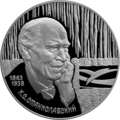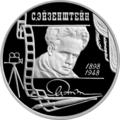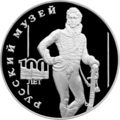This is a list of commemorative coins issued by the Central Bank of Russia in 1998:
| Commemorative coins issued by the Central Bank of Russia in 1998 | ||||||
|---|---|---|---|---|---|---|
| Name [1] | Date of issue [1] | Catalogue number [1] | Nominal value [1] | Total mintage | Image (front) | Image (reverse) |
| Individual issues | ||||||
| World Youth Games | 28 May 1998 | 5109-0030 | 1 ruble | 25,000 [2] |  |  |
| 5109-0031 | 25,000 [3] |  | ||||
| 5109-0032 | 25,000 [4] |  | ||||
| 5109-0033 | 25,000 [5] |  | ||||
| 5109-0034 | 25,000 [6] |  | ||||
| 5109-0035 | 25,000 [7] |  | ||||
| Year of Human Rights in the Russian Federation | 10 December 1998 | 5111-0064 | 3 rubles | 15,000 [8] |  |  |
| Series: Prominent personalities of Russia | ||||||
| 135th anniversary of the birth of K.S. Stanislavski | 19 January 1998 | 5110-0021 | 2 rubles | 15,000 [9] |  |  |
| 5110-0022 | 15,000 [10] |  |  | |||
| 100th anniversary of the birth of S.M. Eisenstein | 23 January 1998 | 5110-0023 | 15,000 [11] |  |  | |
| 5110-0024 | 15,000 [12] |  |  | |||
| 150th anniversary of the birth of V.M.Vasnetsov | 14 May 1998 | 5110-0025 | 15,000 [13] |  |  | |
| 5110-0026 | 15,000 [14] |  |  | |||
| Series: Red Data Book | ||||||
| Japanese skink | 29 September 1998 | 5109-0036 | 1 ruble | 15,000 [15] |  | |
| Laptev Sea walrus | 5109-0037 | 15,000 [16] |  | |||
| Emperor goose | 5109-0038 | 15,000 [17] |  | |||
| Series: Architectural monuments of Russia | ||||||
| 100th anniversary of the Russian Museum | 23 June 1998 | 5111-0058 | 3 rubles | 15,000 [18] |  |  |
| 5111-0059 | 15,000 [19] |  | ||||
| 5111-0060 | 15,000 [20] |  | ||||
| 5111-0061 | 15,000 [21] |  | ||||
| Nilo Stolobenskaya Hermitage | 1 September 1998 | 5111-0062 | 15,000 [22] |  | ||
| Savvino-Storozhevsky Monastery | 26 November 1998 | 5111-0063 | 5,000 [23] |  |  | |